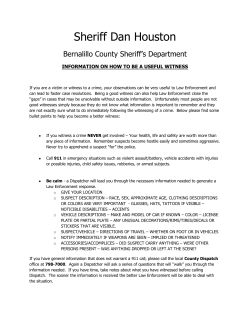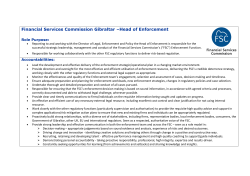
Contract Enforcement and Capital Misallocation in Less
Contract Enforcement and Capital Misallocation in
Less-Developed Economies
Mehran Ebrahimian
Seyed Ali Madanizadeh
Sharif University of Technology
April 15, 2015
Introduction
Introduction
Capital Misallocation in Less-Developed Economies:
• Banerjee and Duflo (2005)
• Output/Worker, USA vs. India:
• Data: 11:1
• Estimation from Aggregate Variables: 6.5:1
• Explaining by Heterogenous Access to Credit
• Hsieh and Klenow (2009)
• Wide range of plants’ TFP in India/China with respect to USA
• Explaining by distorted prices of output/capital for plants
• 30-50% TFP Loss in China
• 40-60% TFP Loss in India
Ebrahimian, Madanizadeh (GSME)
Contract Enforcement and Capital Misallocation
3 / 25
Introduction
Introduction
Capital Productivity in Iran:
Figure: Average Growth of Capital Productivity (%) in Manufacturing
Sectors, 2000:2007. source: Nili et al. (2012)
Ebrahimian, Madanizadeh (GSME)
Contract Enforcement and Capital Misallocation
4 / 25
Introduction
Question
What is the Role of Contract Enforcement in Capital
Misallocation of Less-Developed Economies?
Ebrahimian, Madanizadeh (GSME)
Contract Enforcement and Capital Misallocation
5 / 25
Introduction
The Model
• OLG model with Imperfect Financial Market
• Endogenous Household/Entrepreneur Population
• Financial Market Frictions:
• Asymmetric Information on Borrower’s Productivity
• Poor Contract Enforcement, Strategic Default
Ebrahimian, Madanizadeh (GSME)
Contract Enforcement and Capital Misallocation
6 / 25
Introduction
Main Findings
1
2
Equilibrium Loan Interest Rate diverges, everyone defaults
50% increase in degree of Contract Enforcement:
• 85% gain in Average Capital Productivity (given aggregate level)
• 40% decrease in 90/10 Income Inequality Ratio
• 40% increase in share of Hired Labor in Capital Intensive Sector
Ebrahimian, Madanizadeh (GSME)
Contract Enforcement and Capital Misallocation
7 / 25
Model
Setup
Model Setup
Population:
• The Young:
• Supply Labor Force
• The Old:
• Potential Firms with Different Productivities
1 Supply Capital
2 Operate Firm + Demand Capital/Labor
Ebrahimian, Madanizadeh (GSME)
Contract Enforcement and Capital Misallocation
8 / 25
Model
Setup
Model Setup
Markets:
• Financial Market:
• Competitive
• No friction between depositors and intermediaries
• Asymmetric information on borrower/firm’s productivity
• The possibility of strategic default:
• Borrowers may default on their loans.
• The proportion θ < 1 of their wealth is accessible for intermediaries.
• Labor Market:
• Frictionless
• Exogenous wage
Ebrahimian, Madanizadeh (GSME)
Contract Enforcement and Capital Misallocation
9 / 25
Model
Setup
Model Setup
Timing and Actions Set:
1
The young supply labor.
2
3
The old pick up a productivity (Ai ) from a known distribution.
¯
Intermediaries set returns on deposits (R).
4
The old decide whether to operate firm or not.
• Inactive agents: supply loan to financial intermediaries.
• Businessmen: demand labor, decide on external financing.
5
Intermediaries set return on loans (Ri ).
6
Intermediaries distribute loans (li ) between borrowers.
7
Borrowers decide whether to default or not.
8
Intermediaries pay the returns on deposits.
9
The young consume and save (si ) for the next period.
10
The old consume and die.
Ebrahimian, Madanizadeh (GSME)
Contract Enforcement and Capital Misallocation
10 / 25
Model
Setup
Model Setup
Equilibrium Definition:
Bayesian Nash Equilibrium
Ebrahimian, Madanizadeh (GSME)
Contract Enforcement and Capital Misallocation
11 / 25
Model
The Young
The Young
• Agent i’s Problem:
max log(c1 ) + β log(c2 )
s.t. c1 + s ≤ w
c2 ≤ s(1 + ρi )
→ Inelastic Aggregate Capital Supply
Ebrahimian, Madanizadeh (GSME)
Contract Enforcement and Capital Misallocation
12 / 25
Model
The Old
The Old
• Agent i’s Problem:
max
ρi
subjected to 4 possibilities
1
2
3
4
Making Deposit
Running Business, without taking loan
Running Business, demanding loan, paying the loan
Running Business, demanding loan, defaulting on the loan
¯
s(1 + R)
s(1 + r )
i
s(1 + ρi ) =
[s + l(s)](1 + ri ) − l(s)(1 + Ri )
(1 − θ)[s + l(s)](1 + r )
i
Ebrahimian, Madanizadeh (GSME)
Contract Enforcement and Capital Misallocation
13 / 25
Model
4
The Old
The Old
3.5
• Agent
i’s Decision:
3
¯
1
2
r0,i
1.5
0
−0.5
3
1
0.5
−1
Make Deposit
rndc,i
4
θ
1
1
si
1+R
r0,i = li +s
−1
i 1−θ
li
1+Ri
rndc,i = li +si θ − 1
li /(li + si )
2.5
2
ri
Ri
¯
R
2
0
1
Run
Business
Ebrahimian, Madanizadeh (GSME)
3
2
3
Run
Business
Demand Loan
4
5
Run Business
Demand Loan
Default
4
Contract Enforcement and Capital Misallocation
14 / 25
Model
Firms
Firms
• Firm i’s Problem:
max πi = Ai k α h1−α − wh
{h}
s.t. k ≤ ki
• Firm i’s Decision:
hi = [
(1 − α)Ai 1/α
] ki
w
• Firm i’s Profit:
πi = ri ki
α (1 − α)Ai 1/α
ri :=
[
] w
1−α
w
Ebrahimian, Madanizadeh (GSME)
Contract Enforcement and Capital Misallocation
15 / 25
Model
Intermediaries
Intermediaries
• Monopoly’s Profit:
¯ R) = max Σi li [R − PD (l˜i )(1 + R − θ(1 + r¯)/l˜i )] − Σi li R
¯
πm (R,
l(w)
s.t. Σi li ≤ Ns s
→ li = l(wi ), ˜li = li /(li + wi ), wi : Agent i’s Wealth Demanding for
Loan.
⋄ Proportional Loan.
Ebrahimian, Madanizadeh (GSME)
Contract Enforcement and Capital Misallocation
16 / 25
Model
Intermediaries
Intermediaries
• Symmetric Competitive Equilibrium:
¯ c , Rc , lc (w))
zc = (R
Theorem
1
2
3
¯ c , Rc ) = 0
πm ( R
Ns s = Nd lc (s)
¯ c and Rc maximize πm (R,
¯ R) subjected to R
¯≥R
¯c.
R
Ebrahimian, Madanizadeh (GSME)
Contract Enforcement and Capital Misallocation
17 / 25
Model
Intermediaries
Intermediaries
Definition (R∗ )
1 − F (R∗ ) = θ
Theorem
¯ c ≥ R∗
R
Rc ≥ R∗
Proof.
˜
¯ < R∗ , Loan to Wealth is less than θ.
▷ For R
¯
▷ No Default: πm = (R − R)L.
Ebrahimian, Madanizadeh (GSME)
Contract Enforcement and Capital Misallocation
18 / 25
Model
Intermediaries
Intermediaries
Theorem
¯ and R∗ < R < rmax ,
For R∗ ≤ R
¯ R)
∂πm (R,
>0
∂R
Proof.
˜
¯ Loan to Wealth ratio is more than θ.
▷ For R∗ ≤ R,
▷ Marginal defaulting firms are small.
Ebrahimian, Madanizadeh (GSME)
Contract Enforcement and Capital Misallocation
19 / 25
Model
Intermediaries
Intermediaries
Theorem
• Rc = rmax
¯ c < rmax
• R∗ < R
Proof.
▷
∂πm (R∗ ,R)
∂R
> 0, πm (R∗ , R∗ ) = 0: πm (R∗ , rmax ) > 0
▷ Everyone Defaults: πm (rmax , rmax ) < 0
Ebrahimian, Madanizadeh (GSME)
Contract Enforcement and Capital Misallocation
20 / 25
Results
Numerical Results
Average Capital Productivity
5
σ=5
σ=3
σ=2
σ = 1.5
σ = 1.2
4.5
r¯f irms /¯
ragents
4
Productivity Distribution:
Pareto (σ), Average: 0.5-1
3.5
3
2.5
2
1.5
1
0
0.1
0.2
0.3
0.4
0.5
0.6
0.7
0.8
0.9
1
θ
Ebrahimian, Madanizadeh (GSME)
Contract Enforcement and Capital Misallocation
21 / 25
Results
Numerical Results
90/10 Income Inequality Ratio
6.5
σ=5
σ=3
σ=2
σ = 1.5
σ = 1.2
Productivity Distribution:
Pareto (σ), Average: 0.5-1
6
5.5
r(90%)/r(10%)
5
4.5
4
3.5
3
2.5
2
1.5
1
0
0.1
0.2
0.3
0.4
0.5
0.6
0.7
0.8
0.9
1
θ
Ebrahimian, Madanizadeh (GSME)
Contract Enforcement and Capital Misallocation
22 / 25
Results
Numerical Results
Share of Hired Labor in Capital Intensive Sector
1
σ=5
σ=3
σ=2
σ = 1.5
σ = 1.2
0.9
Productivity Distribution:
Pareto (σ), Average: 0.5
α = 1/3, β = 0.5
0.8
L
0.7
0.6
0.5
0.4
0.3
0
0.1
0.2
0.3
0.4
0.5
0.6
0.7
0.8
0.9
1
θ
Ebrahimian, Madanizadeh (GSME)
Contract Enforcement and Capital Misallocation
23 / 25
Thanks
Ebrahimian, Madanizadeh (GSME)
Contract Enforcement and Capital Misallocation
24 / 25
References
Banerjee, A. V. and E. Duflo (2005). Growth theory through the lens
of development economics. Handbook of economic growth 1, 473–552.
Hsieh, C.-T. and P. J. Klenow (2009). Misallocation and
manufacturing tfp in china and india. The Quarterly Journal of
Economics 124 (4), 1403–1448.
Nili, M., H. Dargahi, and F. Fatemi (2012). Productivity in the
Manufacturing Sector of Iran.
Ebrahimian, Madanizadeh (GSME)
Contract Enforcement and Capital Misallocation
25 / 25
© Copyright 2025









